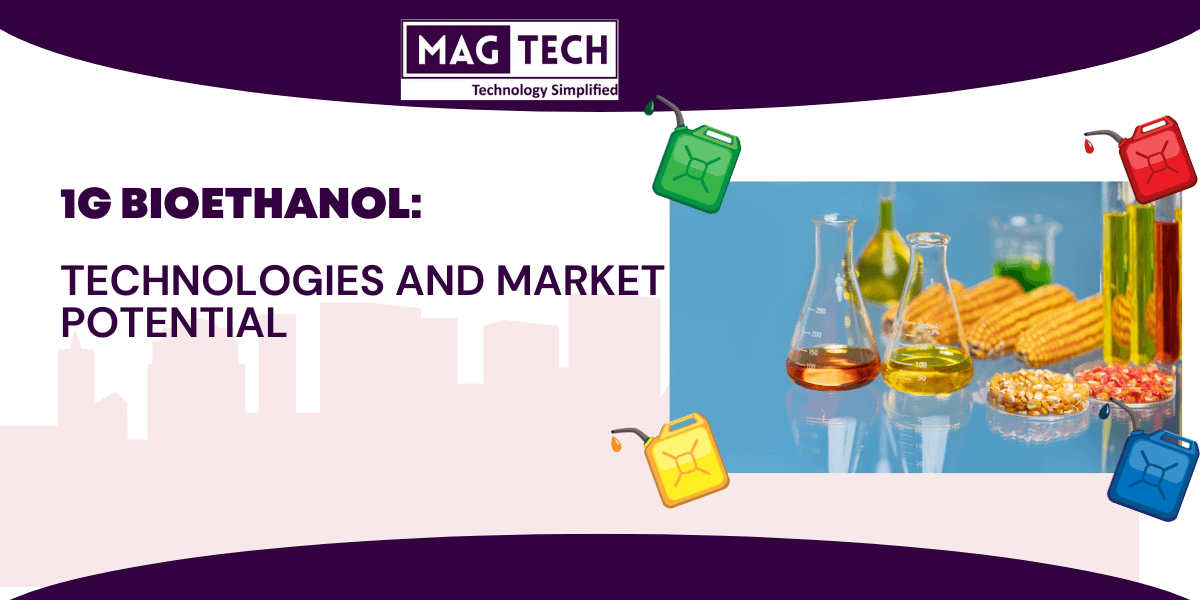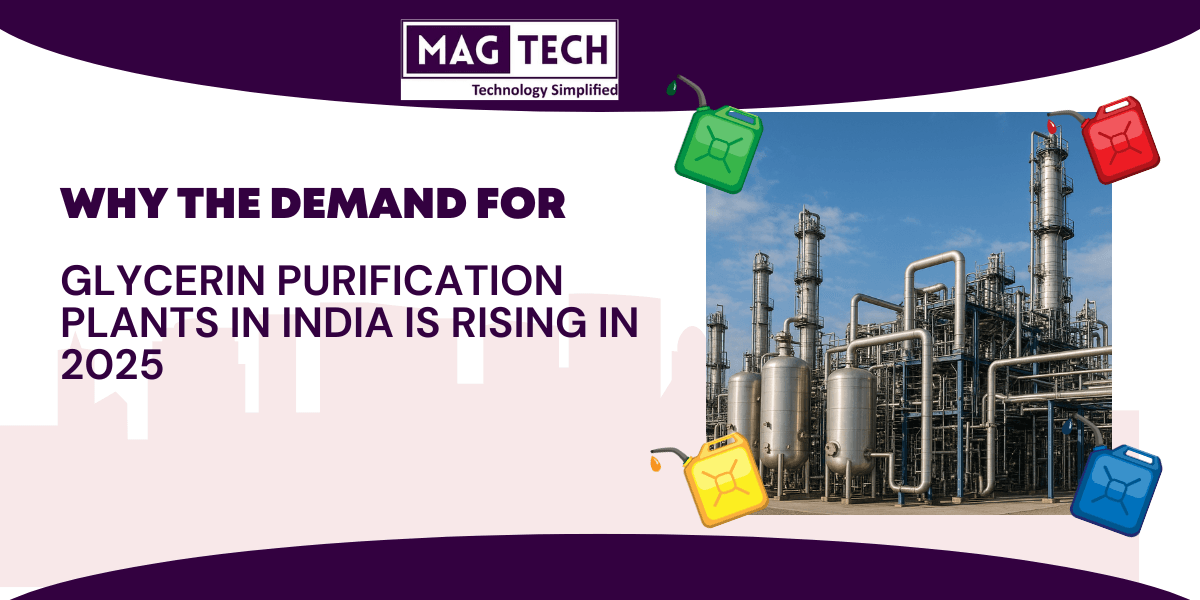Glycerin purification is a valuable opportunity in biodiesel production, turning a byproduct into profit. When biodiesel is made, raw glycerin—rich in impurities like methanol, water, and salts—remains. Rather than disposing of this waste, producers can refine it to create high-purity products by using the latest technology in glycerin purification.
For biodiesel producers, adding glycerin purification makes both economic and environmental sense, enhancing their overall business profitability and impact. Here is how contemporary biodiesel producers are purifying glycerin.
Table of Contents
ToggleConventional Glycerin Purification Methods Adopted by Biodiesel Producers:
In biodiesel production, glycerin emerges as a key byproduct. Typically, about 10 wt. % of crude glycerin is produced for every 100 liters of biodiesel. However, this crude glycerin contains impurities—methanol, water, and soap—that limit its market value. To transform it into a high-value product, producers use a multi-step purification process.
- Pre-treatment: Filtration removes solid impurities; subsequently, sulfuric acid breaks down the remaining soap, and then a decanter separates the acid oil layer.
- Neutralization: The glycerin is neutralized using a pH adjuster to adjust its pH.
- Methanol removal: Heating and vacuum treatment eliminate residual methanol.
- Moisture reduction: A vacuum dryer preheats and dries the glycerin to remove excess moisture.
- Distillation and evaporation: Distillation separates glycerin from impurities, followed by thin-film evaporation to remove salts and moisture for further refinement.
This common process uses conventional technology in glycerin purification. Vivid research is going on worldwide to make this purification process more efficient for biodiesel manufacturers.
Advanced Technology in Glycerin Purification: An Overview
Using the latest technology in glycerin purification, producers can remove complex impurities more efficiently and turn crude glycerin into a valuable, market-ready product while reducing waste.
Researchers are developing purification methods for industrial implementation.
Adsorption Technology for Glycerin Purification
Adsorption is often the final step in glycerin purification, used to reduce color and odor by removing smaller fatty acids. This step is crucial for improving the quality and transparency of glycerin, especially for high-purity applications. Below are key techniques and findings in adsorption:
1. Activated Carbon and Waste Adsorbents:
People are traditionally using activated carbon to remove impurities; however, now they are exploring more eco-friendly options, such as bentonite (a type of clay) and tea waste. These materials are cheaper and more environmentally friendly.
2. Chemical Activation:
Chemicals, such as sulfuric acid, need to treat some waste materials like bentonite to improve their ability to absorb impurities.
3. Optimization of Conditions:
To get the best results, certain conditions need to be controlled:
- Contact Time: How long the adsorbent is in contact with the glycerol, typically between 30 minutes and 2 hours.
- Temperature: The process works best at temperatures between 50°C and 75°C.
- Adsorbent Loading: You don’t need much-activated carbon—just about 1% can be effective, especially when combined with other materials like organoclay. This reduces material use by up to 60%.
4. Bio-Sorbents:
Tea waste treated with sodium hydroxide, in fact, effectively purifies glycerol, thereby reaching up to 95.95% purity at 60°C and for a duration of 90 minutes
5. Innovative Materials:
New materials, such as activated carbon from wastewater sludge, are testing and, furthermore, showing high purification rates when properly activated.
Vacuum Distillation for Glycerin Purification:
Vacuum distillation is a proven technology for purifying glycerin, especially effective in treating crude glycerol with high salt and MONG (matter organic non-glycerol) content.
Here’s an overview of how it works and its limitations:
1. Principle and Process:
- In vacuum distillation: glycerin is purified at lower pressures and temperatures to avoid undesirable reactions
- Low pH Control: The process typically operates at a pH below 5 to prevent foaming and unwanted chemical changes.
- Temperature Sensitivity: Crude glycerol, therefore, distills at moderate temperatures, specifically between 120–126°C, in order to reduce risks such as glycerol polymerization, acrolein formation, or oxidation.
2. Side Reactions:
- At high pH, glycerol can polymerize to polyglycerol if sodium hydroxide is present in excess.
- At low pH levels, glycerol can dehydrate into acrolein.
- Oxidation may occur, producing compounds like glycerose (a mixture of glyceraldehyde and dihydroxyacetone).
3. Performance Results:
- When performed under optimal conditions, vacuum distillation can produce glycerol of 96-97% purity.
- However, these low pressures are often impractical for larger industrial applications, where higher vacuums (10–30 mbar) are typically used.
Therefore, vacuum distillation is an effective method for glycerin purification, offering high-purity glycerin with minimal thermal degradation. It operates at lower temperatures, reducing energy consumption and preserving glycerin quality. Ideal for scalable operations, it efficiently removes volatile impurities, making it a sustainable, high-quality solution for biodiesel producers.
4. Ion-Exchange Resins in Glycerin Purification:
Ion-exchange resins offer an effective additional step in glycerin purification, particularly for removing low amounts of salts from aqueous glycerol solutions . This method is energy-efficient and allows the resins to be regenerated after use, which makes it a sustainable option for refining glycerin.
Here’s an overview of how it works and its application:
- In the ion-exchange process, ions from the crude glycerol solution are swapped with the cationic and anionic ions in the resin.
- This exchange results in water formation, which is later removed to yield purified glycerin.
- Since the process is not energy-intensive, it’s relatively cost-effective compared to methods like vacuum distillation.
5. Adjustable Parameters:
- The bed height of the resin, residence time of the glycerol solution, and operating temperature can be modified to optimize the purification process.
- Ion-exchange resins can be selected and tailored based on specific requirements, such as the salt concentration in crude glycerol.
6. Common Resins and Techniques:
- Typical cation-exchange and anion-exchange resins.
- A multi-step ion exchange (e.g., a cationic step followed by one or more anionic steps)
- Silica beads may be added to reduce moisture content
The ion-exchange resins are a suitable and adaptable choice for refining glycerin, especially when salt levels are low, making it an important component in multi-step glycerin purification processes.
7. Coagulation and Flocculation in Glycerin Purification:
Coagulation and flocculation are effective methods to purify crude glycerol by removing ions and destabilizing suspended particles. This two-step process involves:
- Coagulation: A coagulant agent is added to the crude glycerol to neutralize the charges of colloidal particles, causing them to aggregate.
- Flocculation: These aggregated particles then form larger clumps, which settle out of the solution, allowing for easier removal.
This method is promising for ion removal in crude glycerol, as it reduces contaminants like chloride, iron, aluminum, and magnesium. For example, cationic polymers, such as condensed tannin derivatives, can achieve up to 77.3% purity in pre-treatment.
Although still under-researched, coagulation and flocculation provide an efficient route for glycerin purification with the potential for broader applications.
Membrane Separation Technology for Glycerin Purification:
1. Pressure-Driven Membrane Separation:
Pressure-driven membrane separation uses membranes to filter crude glycerin based on pore size and pressure. This method, efficient in energy use, avoids additional chemicals, making it a viable alternative to traditional distillation.
Ceramic membranes are especially popular due to their durability, higher permeability, and ease of cleaning. Using cross-flow filtration with ceramic membranes yielded high glycerin purity at lower pressures.
However, membrane fouling—clogging due to contaminants—poses a challenge. To mitigate this, pre-treatments are necessary, and membranes must undergo periodic cleaning, which increases operating costs. Despite this, the process remains attractive for smaller plants due to its lower energy requirements compared to conventional methods.
2. Thermally Driven Membrane Separation:
Thermally driven membrane techniques, such as membrane distillation (MD), use temperature differences to create vapor pressure across a membrane, separating glycerin from water and other volatiles. MD variants include direct contact membrane distillation (DCMD), air gap membrane distillation (AGMD), and vacuum membrane distillation (VMD).
Hydrophobic membranes, therefore, effectively separated dilute glycerin solutions at 65°C with minimal energy costs in sweep gas membrane distillation (SGMD).
3. Electrodialysis:
Electrodialysis (ED) is an efficient membrane separation technique for purifying crude glycerol, particularly for desalting applications. The process employs ion-exchange membranes to remove salts and impurities, improving glycerol quality for further use. Studies have demonstrated that ED can achieve high levels of desalting, with over 95% separation of target salts from synthetic glycerol solutions.
Key factors influencing process efficiency include salt concentration and the water-to-glycerol ratio, with higher salt content leading to longer operating times. In some cases, using different ion-exchange membranes achieved desalination rates of up to 92% after several hours of operation.
Challenges in Implementing Advanced Glycerin Purification Technologies
Implementing advanced glycerin purification technologies comes with several challenges:
- High Capital and Operational Costs: Technologies like vacuum distillation, ion-exchange resins, and membrane separation require significant upfront investment in equipment and ongoing maintenance, making them less accessible for small- and medium-sized biodiesel producers.
- Complex Operational Requirements: These methods demand precise control over parameters such as temperature, pressure, and chemical reactions. For example, maintaining optimal conditions for membrane filtration or ion exchange processes can be technically challenging.
- Energy Consumption: Some technologies, particularly vacuum distillation, require high amounts of energy to operate at low pressures, increasing operational costs and reducing efficiency.
- Scalability Issues: While these advanced technologies may be effective at a small scale, scaling them for large industrial applications can reduce their efficiency and increase costs, posing challenges for large biodiesel plants.
- Maintenance and Downtime: Techniques like membrane filtration and ion exchange resins can experience fouling or clogging, leading to increased maintenance needs and potential downtime.
Despite these hurdles, we expect continued research and technological advancements to mitigate these challenges over time.
Life Cycle Assessment of Glycerin Purification Technologies
A recent life cycle assessment (LCA) study comparing different glycerol purification processes revealed that membrane distillation has the highest carbon footprint (3466.82 kg CO2 eq./FU), followed by ion-exchange (2239.71 kg CO2 eq./FU) and vacuum distillation (1745.72 kg CO2 eq./FU). This highlights the environmental impact of these technologies and the importance of selecting the right purification method based on both economic and ecological considerations.
Partner with MAGTECH for Efficient Glycerin Purification Solutions
Confused while choosing the right technology in glycerin purification? Reach us to understand the advancement in this sector and utilize the potential of glycerin purification for your biodiesel plant.
With over 10 years of experience in biodiesel manufacturing, MAGTECH combines its diverse expertise in advanced purification technologies with cutting-edge research. Our solutions, improvised to your production scale, will ensure high-quality glycerin recovery without the hefty costs.
As a trusted partner in the biodiesel industry, MAGTECH provides cost-effective and scalable solutions that align with your business goals. Let us help you improve your glycerin purification process—contact us today to learn how we can support your success.
Ref URLs:
https://www.sciencedirect.com/science/article/pii/S0016236123000984#s0080
https://www.frontiersin.org/journals/chemistry/articles/10.3389/fchem.2019.00774/full
https://biodieselmagazine.com/articles/an-innovation-in-glycerin-purification-2388
https://www.frontiersin.org/journals/chemistry/articles/10.3389/fchem.2019.00774/full
https://www.srsbiodiesel.com/technologies/glycerin-purification/
https://www.mdpi.com/2071-1050/14/3/1747


